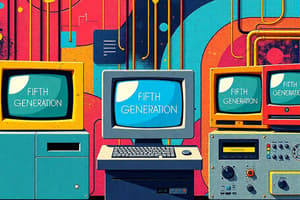Podcast
Questions and Answers
Who designed the ENIAC, a prime example of a first-generation computer?
Who designed the ENIAC, a prime example of a first-generation computer?
- Charles Babbage
- Steve Jobs
- John W. Mauchly and J. Presper Eckert (correct)
- Alan Turing
Which generation of computers emerged in the aftermath of World War II?
Which generation of computers emerged in the aftermath of World War II?
- Second generation
- Fourth generation
- First generation (correct)
- Third generation
What was the primary component for processing and storage in first-generation computers?
What was the primary component for processing and storage in first-generation computers?
- Microprocessors
- Integrated circuits
- Transistors
- Vacuum tubes (correct)
What was a significant limitation of vacuum tubes in first-generation computers?
What was a significant limitation of vacuum tubes in first-generation computers?
Which generation of computers was a massive leap forward in terms of technology and efficiency?
Which generation of computers was a massive leap forward in terms of technology and efficiency?
What component replaced vacuum tubes as the primary components in the second-generation computers?
What component replaced vacuum tubes as the primary components in the second-generation computers?
Which computer system, launched in 1964, is considered an iconic example of a second-generation computer?
Which computer system, launched in 1964, is considered an iconic example of a second-generation computer?
What did the first computer to use integrated circuits contribute to the evolution of computers?
What did the first computer to use integrated circuits contribute to the evolution of computers?
Which innovation of the second generation of computers revolutionized the way people interacted with computers?
Which innovation of the second generation of computers revolutionized the way people interacted with computers?
How did transistors differ from vacuum tubes in terms of power consumption?
How did transistors differ from vacuum tubes in terms of power consumption?
Flashcards
First Generation Computers
First Generation Computers
Early computers (1945-1963) using vacuum tubes for processing and storage.
Vacuum Tubes
Vacuum Tubes
Electronic components in early computers, prone to failure and inefficient.
ENIAC
ENIAC
A famous first-generation computer, revolutionary for its time.
Second Generation Computers
Second Generation Computers
Signup and view all the flashcards
Transistors
Transistors
Signup and view all the flashcards
IBM System/360
IBM System/360
Signup and view all the flashcards
Integrated Circuits
Integrated Circuits
Signup and view all the flashcards
Time-Sharing Systems
Time-Sharing Systems
Signup and view all the flashcards
Compatible Time-Sharing System (CTSS)
Compatible Time-Sharing System (CTSS)
Signup and view all the flashcards
Computing Evolution
Computing Evolution
Signup and view all the flashcards
Study Notes
Computing: Generation of Computers - A Journey Through First and Second-Generation Computers
Introduction
Computing, as we know it today, has evolved from humble beginnings that trace their roots to the early pioneers of electronic computing. This article delves into the fascinating era of the first and second-generation computers, a phase that laid the groundwork for modern computing technology.
First Generation (1945-1963)
The first generation of computers, also known as vacuum tubes computers, emerged in the aftermath of World War II. These machines were the first to translate mathematical problems into electronic signals, and they relied on vacuum tubes as the primary components for processing and storage.
The ENIAC (Electronic Numerical Integrator and Computer), created in 1945, is a prime example of a first-generation computer. It was designed by John W. Mauchly and J. Presper Eckert and embodied a host of innovations. The ENIAC was capable of performing 5,000 additions and 357 multiplications per second, making it a significant step forward from electromechanical computing.
Vacuum tubes, however, were not efficient in terms of power usage and were prone to failure. As a result, they became the bottleneck for these early computers, which limited their speed and reliability.
Second Generation (1963-1970)
The second generation of computers, which emerged in the 1960s, was a massive leap forward in terms of technology and efficiency. Transistors replaced vacuum tubes as the primary components, ushering in a new era of computing.
Transistors were smaller, easier to manufacture, and more reliable than vacuum tubes, making it possible to build more compact and powerful computers. Furthermore, transistors required less power compared to vacuum tubes, which translated to a more efficient use of resources.
IBM's System/360, launched in 1964, is an iconic example of a second-generation computer. The System/360 was designed to support a range of application configurations, making it a versatile and adaptable system. It was also the first computer to use integrated circuits, which further consolidated the components into smaller packages, reducing power consumption and size.
The second generation of computers also marked the birth of time-sharing systems, such as the Compatible Time-Sharing System (CTSS). CTSS, introduced in 1961, enabled multiple users to access the computer simultaneously, thereby revolutionizing the way people interacted with computers.
Conclusion
The first and second generations of computers laid the foundation for modern computing technology. Vacuum tubes and transistors have given way to integrated circuits and semiconductors, but the innovations of the past continue to influence the present and future of the computing world.
Today, computers are faster, more powerful, and more efficient than ever before, and this evolution is a testament to the hard work and ingenuity of the pioneers who laid the groundwork for the modern computing landscape.
Studying That Suits You
Use AI to generate personalized quizzes and flashcards to suit your learning preferences.




